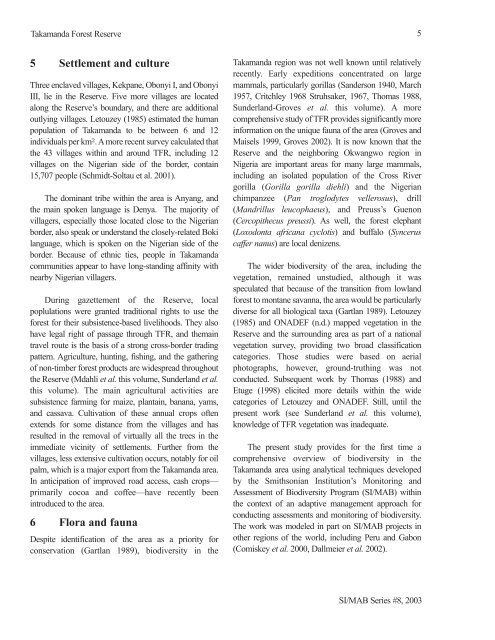Fisheries in the Southern Border Zone of Takamanda - Impact ...
Fisheries in the Southern Border Zone of Takamanda - Impact ...
Fisheries in the Southern Border Zone of Takamanda - Impact ...
Create successful ePaper yourself
Turn your PDF publications into a flip-book with our unique Google optimized e-Paper software.
<strong>Takamanda</strong> Forest Reserve<br />
5 Settlement and culture<br />
Three enclaved villages, Kekpane, Obonyi I, and Obonyi<br />
III, lie <strong>in</strong> <strong>the</strong> Reserve. Five more villages are located<br />
along <strong>the</strong> Reserve’s boundary, and <strong>the</strong>re are additional<br />
outly<strong>in</strong>g villages. Letouzey (1985) estimated <strong>the</strong> human<br />
population <strong>of</strong> <strong>Takamanda</strong> to be between 6 and 12<br />
<strong>in</strong>dividuals per km 2. A more recent survey calculated that<br />
<strong>the</strong> 43 villages with<strong>in</strong> and around TFR, <strong>in</strong>clud<strong>in</strong>g 12<br />
villages on <strong>the</strong> Nigerian side <strong>of</strong> <strong>the</strong> border, conta<strong>in</strong><br />
15,707 people (Schmidt-Soltau et al. 2001).<br />
The dom<strong>in</strong>ant tribe with<strong>in</strong> <strong>the</strong> area is Anyang, and<br />
<strong>the</strong> ma<strong>in</strong> spoken language is Denya. The majority <strong>of</strong><br />
villagers, especially those located close to <strong>the</strong> Nigerian<br />
border, also speak or understand <strong>the</strong> closely-related Boki<br />
language, which is spoken on <strong>the</strong> Nigerian side <strong>of</strong> <strong>the</strong><br />
border. Because <strong>of</strong> ethnic ties, people <strong>in</strong> <strong>Takamanda</strong><br />
communities appear to have long-stand<strong>in</strong>g aff<strong>in</strong>ity with<br />
nearby Nigerian villagers.<br />
Dur<strong>in</strong>g gazettement <strong>of</strong> <strong>the</strong> Reserve, local<br />
poplulations were granted traditional rights to use <strong>the</strong><br />
forest for <strong>the</strong>ir subsistence-based livelihoods. They also<br />
have legal right <strong>of</strong> passage through TFR, and <strong>the</strong>ma<strong>in</strong><br />
travel route is <strong>the</strong> basis <strong>of</strong> a strong cross-border trad<strong>in</strong>g<br />
pattern. Agriculture, hunt<strong>in</strong>g, fish<strong>in</strong>g, and <strong>the</strong> ga<strong>the</strong>r<strong>in</strong>g<br />
<strong>of</strong> non-timber forest products are widespread throughout<br />
<strong>the</strong> Reserve (Mdahli et al. this volume, Sunderland et al.<br />
this volume). The ma<strong>in</strong> agricultural activities are<br />
subsistence farm<strong>in</strong>g for maize, planta<strong>in</strong>, banana, yams,<br />
and cassava. Cultivation <strong>of</strong> <strong>the</strong>se annual crops <strong>of</strong>ten<br />
extends for some distance from <strong>the</strong> villages and has<br />
resulted <strong>in</strong> <strong>the</strong> removal <strong>of</strong> virtually all <strong>the</strong> trees <strong>in</strong> <strong>the</strong><br />
immediate vic<strong>in</strong>ity <strong>of</strong> settlements. Fur<strong>the</strong>r from <strong>the</strong><br />
villages, less extensive cultivation occurs, notably for oil<br />
palm, which is a major export from <strong>the</strong> <strong>Takamanda</strong> area.<br />
In anticipation <strong>of</strong> improved road access, cash crops—<br />
primarily cocoa and c<strong>of</strong>fee—have recently been<br />
<strong>in</strong>troduced to <strong>the</strong> area.<br />
6 Flora and fauna<br />
Despite identification <strong>of</strong> <strong>the</strong> area as a priority for<br />
conservation (Gartlan 1989), biodiversity <strong>in</strong> <strong>the</strong><br />
<strong>Takamanda</strong> region was not well known until relatively<br />
recently. Early expeditions concentrated on large<br />
mammals, particularly gorillas (Sanderson 1940, March<br />
1957, Critchley 1968 Struhsaker, 1967, Thomas 1988,<br />
Sunderland-Groves et al. this volume). A more<br />
comprehensive study <strong>of</strong> TFR provides significantly more<br />
<strong>in</strong>formation on <strong>the</strong> unique fauna <strong>of</strong> <strong>the</strong> area (Groves and<br />
Maisels 1999, Groves 2002). It is now known that <strong>the</strong><br />
Reserve and <strong>the</strong> neighbor<strong>in</strong>g Okwangwo region <strong>in</strong><br />
Nigeria are important areas for many large mammals,<br />
<strong>in</strong>clud<strong>in</strong>g an isolated population <strong>of</strong> <strong>the</strong> Cross River<br />
gorilla (Gorilla gorilla diehli) and <strong>the</strong> Nigerian<br />
chimpanzee (Pan troglodytes vellerosus), drill<br />
(Mandrillus leucophaeus), and Preuss’s Guenon<br />
(Cercopi<strong>the</strong>cus preussi). As well, <strong>the</strong> forest elephant<br />
(Loxodonta africana cyclotis) and buffalo (Syncerus<br />
caffer nanus) are local denizens.<br />
The wider biodiversity <strong>of</strong> <strong>the</strong> area, <strong>in</strong>clud<strong>in</strong>g <strong>the</strong><br />
vegetation, rema<strong>in</strong>ed unstudied, although it was<br />
speculated that because <strong>of</strong> <strong>the</strong> transition from lowland<br />
forest to montane savanna, <strong>the</strong> area would be particularly<br />
diverse for all biological taxa (Gartlan 1989). Letouzey<br />
(1985) and ONADEF (n.d.) mapped vegetation <strong>in</strong> <strong>the</strong><br />
Reserve and <strong>the</strong> surround<strong>in</strong>g area as part <strong>of</strong> a national<br />
vegetation survey, provid<strong>in</strong>g two broad classification<br />
categories. Those studies were based on aerial<br />
photographs, however, ground-truth<strong>in</strong>g was not<br />
conducted. Subsequent work by Thomas (1988) and<br />
Etuge (1998) elicited more details with<strong>in</strong> <strong>the</strong> wide<br />
categories <strong>of</strong> Letouzey and ONADEF. Still, until <strong>the</strong><br />
present work (see Sunderland et al. this volume),<br />
knowledge <strong>of</strong> TFR vegetation was <strong>in</strong>adequate.<br />
The present study provides for <strong>the</strong> first time a<br />
comprehensive overview <strong>of</strong> biodiversity <strong>in</strong> <strong>the</strong><br />
<strong>Takamanda</strong> area us<strong>in</strong>g analytical techniques developed<br />
by <strong>the</strong> Smithsonian Institution’s Monitor<strong>in</strong>g and<br />
Assessment <strong>of</strong> Biodiversity Program (SI/MAB) with<strong>in</strong><br />
<strong>the</strong> context <strong>of</strong> an adaptive management approach for<br />
conduct<strong>in</strong>g assessments and monitor<strong>in</strong>g <strong>of</strong> biodiversity.<br />
The work was modeled <strong>in</strong> part on SI/MAB projects <strong>in</strong><br />
o<strong>the</strong>r regions <strong>of</strong> <strong>the</strong> world, <strong>in</strong>clud<strong>in</strong>g Peru and Gabon<br />
(Comiskey et al. 2000, Dallmeier et al. 2002).<br />
5<br />
SI/MAB Series #8, 2003

















